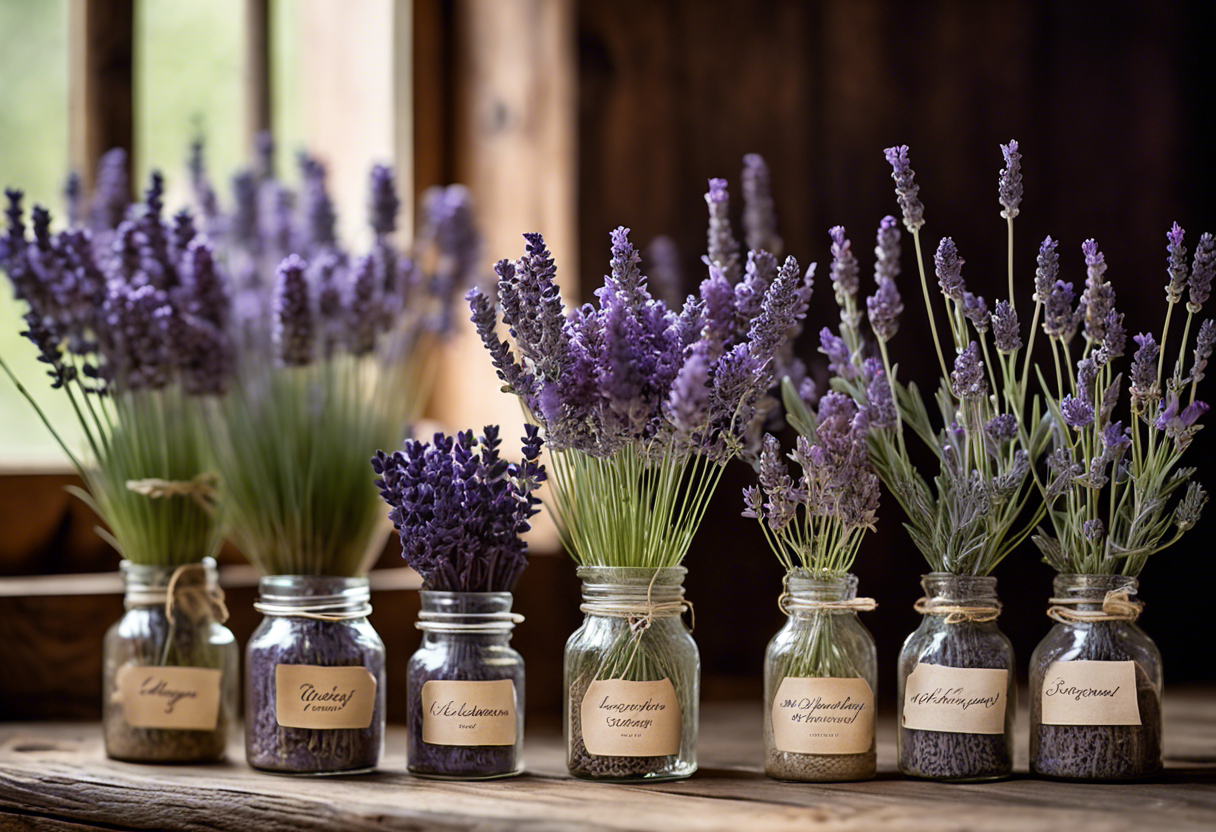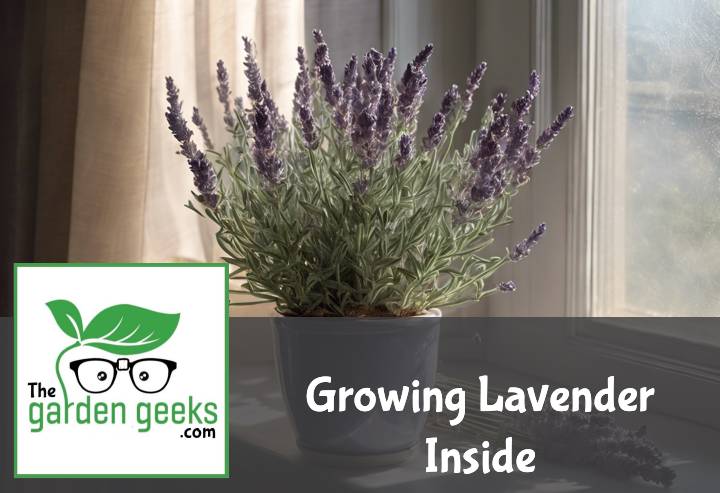Ever tried Growing Lavender Inside? I did, and let me tell you, it’s like having a little piece of Provence right in your living room. Not to mention the sweet, calming scent that fills the air – pure bliss!
But don’t be fooled by its delicate purple blooms. Growing lavender inside can be a bit tricky. But hey, no need to panic! Stick around and I’ll share my top 5 tips to help you keep your indoor lavender happy and thriving. “Keep reading about Growing Lavender Inside (5 Important Tips)”.
Key Takeaways
- Choose a pot with good drainage and use well-draining soil to prevent root rot.
- Lavender needs at least 8 hours of sunlight daily, so place it near a south-facing window.
- Maintain indoor temperatures between 60-70°F for optimal growth.
- Water sparingly; let the top two inches of soil dry out before watering again.
- Prune regularly to promote bushy growth and more blooms.

Why Grow Lavender Indoors?
Growing lavender inside isn’t just a whim, it’s a smart move. It’s all about the benefits and ideal conditions that make indoor lavender cultivation a top choice for many herb enthusiasts.
Benefits of Indoor Lavender
First off, let’s talk about the aesthetic appeal. Having an indoor lavender plant is like having a piece of Provence right in your living room. The vibrant purple flowers are a sight for sore eyes, especially during those dreary winter months.
But it doesn’t stop at just looking pretty. The fragrance of indoor lavender is something else! It fills your home with a soothing scent that can help reduce stress and anxiety. Talk about aromatherapy!
And then there are the potential health benefits. Yes, you heard that right! Health benefits of indoor lavender include improved sleep quality and even better skin health thanks to its antibacterial properties.
Ideal Conditions for Indoor Lavender Growth
Now let’s get down to business – what does lavender need to thrive indoors? Well, light is key. Light requirements for indoor lavender are quite specific – they need lots of it but not too direct as it can scorch their delicate leaves.
Next up is temperature. Lavenders aren’t fans of extreme heat or cold so maintaining an average room temperature works best for indoor lavender growth.
Finally, we have humidity levels. Despite being Mediterranean plants, lavenders don’t require high humidity levels. In fact, they prefer their environment on the drier side which makes them perfect candidates for indoor herb gardening.
How to Choose the Right Lavender Variety for Indoors?

Choosing the right lavender variety for indoor growth is a crucial step in growing lavender inside. It’s not just about picking a pretty plant; it’s about understanding different varieties and identifying those best suited for indoor cultivation.
Understanding Different Varieties of Lavender
Lavender comes in all shapes and sizes, each with its unique characteristics. Some types of lavender plants are more robust, while others require more care and attention. The differences in lavender varieties can significantly impact their suitability for indoor growth.
For instance, some lavenders might be too large for your window sill, while others might not thrive without ample sunlight. So when you’re choosing lavender plants, it’s essential to understand these differences and select a variety that aligns with your living conditions.
Best Varieties for Indoor Cultivation
Now let’s talk about the crème de la crème of indoor lavenders. If you’re looking for the best indoor lavenders, look no further than French Lavender (Lavandula dentata) or Fernleaf Lavender (Lavandula multifida). These top varieties for indoor growth are compact, fragrant, and relatively easy to care for.
The French Lavender is particularly suitable for indoors because it can tolerate indoor conditions better than most other varieties. On the other hand, Fernleaf Lavender is known for its beautiful fern-like foliage and vibrant purple flowers – a perfect addition to brighten up any room!
So there you have it! Remember that successful indoor cultivation of lavenders starts with choosing the right variety. Happy planting!

What are the Essential Requirements for Growing Lavender Inside?
When it comes to indoor lavender care, there’s a bit more to it than just sticking a plant in a pot and hoping for the best. You gotta know your lavender’s needs, mate!
Light Requirements
Now, let’s talk about lavender light needs. These little beauties love their sunlight! They need at least 3-4 hours of direct sunlight each day for optimal growth. So, place them near a south-facing window where they can soak up all that lovely sun.
But what if you’re living in an apartment with limited natural light? No worries! You can use fluorescent lights or grow lights as an alternative. Just make sure your indoor lavenders get enough light exposure every day.
Temperature and Humidity Needs
Next up is temperature and humidity. Lavenders aren’t too fussy about temperature, but they do prefer cooler conditions. Aim for temperatures between 60-65°F (15-18°C) during the day and slightly lower at night.
As for humidity, well, lavenders are like that friend who hates humid weather. They prefer lower humidity levels, so avoid placing them in damp areas like bathrooms or kitchens. If your home is naturally humid, consider using a dehumidifier to help maintain ideal humidity levels for lavenders.
Soil Preferences
Finally, let’s dig into soil preferences (pun intended!). When it comes to soil, lavenders are pretty picky. They prefer well-draining soil with neutral to slightly alkaline pH levels.
A good mix would be one part coarse sand to two parts potting soil with some lime mixed in to raise the pH level. This will ensure your indoor lavender plants have the best possible environment for growth.
Remember folks, when it comes to growing lavender indoors, understanding these essential requirements is key!
How to Care for Indoor Lavender Plants?
When it comes to indoor lavender care, there’s a bit more than just sticking the plant in a pot and hoping for the best. It’s about understanding their needs and giving them the right amount of love (and water!).
Watering Techniques
First things first, watering indoor lavender isn’t rocket science, but it does require some finesse. You see, lavenders aren’t big fans of wet feet. They prefer their soil to be on the drier side. So, how often should you water? Well, once the top inch of soil feels dry to touch, that’s your cue.
But don’t go overboard with watering! Overwatered lavenders are a sorry sight indeed. Signs of an overwatered lavender include yellow leaves and wilting growth. On the flip side, if your lavender is dropping leaves or has curled foliage, it might be crying out for more water – classic underwatered indoor lavender symptoms.
Pruning and Maintenance Tips
Next up on our agenda: pruning and maintenance. Now don’t get scared by the word ‘pruning’. It’s not as daunting as it sounds! In fact, pruning indoor lavenders can be quite therapeutic (or maybe that’s just me?). The best time to prune is after flowering – this encourages bushier growth and more blooms next season.
Remember though, when pruning your lavender plant indoors, always use clean shears to avoid spreading diseases. And never cut into old wood – stick to removing spent flowers and light shaping.
Dealing with Pests and Diseases
Finally, let’s talk about those pesky pests and diseases that seem hell-bent on ruining our indoor lavender plants‘ day (or life). Common culprits include aphids and spider mites – tiny critters that suck sap from your plant. If you spot these, a good wash with soapy water should send them packing.
As for diseases, root rot is the main offender, usually caused by overwatering (told you not to drown them!). To prevent this, ensure your pot has good drainage and don’t let your lavender sit in water. If your plant does get infected, treating diseased lavenders indoors might involve repotting into fresh soil or even replacing the plant if it’s too far gone.
And there you have it! A crash course in growing lavender inside. Remember: less water, more love!
How to Harvest and Use Indoor-Grown Lavender?
So, you’ve been growing lavender inside and now it’s time for the big payoff – harvest! But when exactly is the best time to do this? And how should you go about it? Don’t worry, we’ve got you covered.
When and How to Harvest
The best time to harvest indoor lavender is when the buds are just about to open. This is when they’re at their most fragrant. So keep a keen eye on your plant, and once those buds start swelling up, get ready for action!
Now, onto the how to harvest homegrown lavender part. It’s pretty simple really. All you need is a pair of sharp scissors or pruning shears. Cut the stems about two inches from the base of the plant. Be careful not to cut into the woody part though.
Remember, harvesting homegrown lavender isn’t rocket science. Just be gentle with your plant and it’ll reward you with plenty of aromatic blooms.
Uses of Homegrown Lavender
Once you’ve harvested your indoor-grown lavender, there are so many ways you can use it around your home! For starters, dried lavender makes for an excellent natural air freshener.
But that’s not all! The benefits of indoor-grown lavender extend beyond just making your house smell nice. You can also use it in homemade beauty products like bath salts or body scrubs.
And let’s not forget about cooking! Yes, that’s right – lavender can add a unique flavor to dishes like cookies or lemonade. So don’t be afraid to get creative with your homegrown lavender uses!

To Wrap Up
Growing Lavender Inside is like hosting a little piece of French countryside in your living room. Just remember, treat it like a cat on a diet – not too much water!
So why wait? Grab a pot, some soil and start your lavender journey today! For more tips, check out this Growing Lavender Inside guide.


